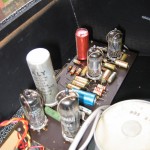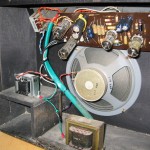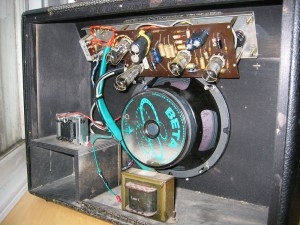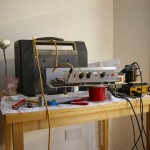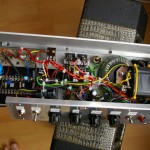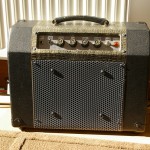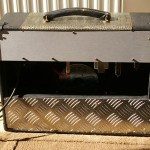This is another long-running project that started out as a Selmer Corvette practice amp obtained from a junk shop. The Corvette was an inexpensive 3 watt practice amp, equipped with two ECC83/12AX7 valves (one for amplifying, another for a tremolo oscillator) one EL84 and one EZ80 rectifier. The whole lot blasting through an 8″ Elac speaker in a fetching croc-skin covered cabinet, with hardboard back, gold plexi front panel, and grill cloth in a shade I can only describe as “porridge” 🙂
When received, it contained the original Mullard tubes and was in working order. It hummed a lot, the knobs crackled when turned, and the tremolo sounded a bit sputtery. But, it had a nice fat tone that turned into a really vicious grind at full volume. Think of a tiny raging Marshall with a hint of malfunctioning Fuzz Face.
I started by cleaning the pots with contact cleaner, cleaning the cabinet, and replacing the input jack sockets and all of the electrolytic caps. This didn’t make much difference to the tone, and it still hummed. So, I added a choke to the power supply, which got rid of the hum nicely. I played it like this for a long time, it was a handy amp for practice and jam sessions. I even used it at a few gigs, but it wasn’t loud enough.
One day it got a huge hole ripped in the porridge grill cloth while kicking around my car, so I decided to mod it some more. I ripped off the old cloth, enlarged the speaker hole, and installed an Eminence Beta 8 that I had lying around, with a new wire mesh grill. That didn’t make it any louder, and it still sounded much the same, but it didn’t flap and fart so uselessly at high volume.
Then I had a crazy idea. I knew that this little amp really longed to be a monster that would make Marshall stacks flee in terror. 🙂 And, it now had a speaker that could stand much more power. Why not make it into a hybrid? In the lab, I cooked up a transistor output stage inspired by the ones in the old Thomas Vox and Leslie power amps, that could be driven off the existing output transformer. When I switched it on, I was expecting it to explode or sound terrible. But to my surprise, it sounded just like the original amp, only louder. A lot louder! My first prototype measured 70 watts before clipping.
This concept lay around as a half-finished breadboard for months, as I was so busy with work, but eventually I got around to rebuilding it. I tossed out the original Selmer PCB and built a new aluminium chassis, that would hold all the valve and solid-state parts, and double as a heatsink for the output transistors. I rebuilt the original Corvette circuit with fresh components, using point-to-point wiring on tagboards, tube sockets on rubber shock mounts, and leaving out the tremolo. I also added a MOSFET follower to vary the screen voltage, and dumped the rectifier tube in favour of some silicon diodes.
The old tremolo speed knob became the screen voltage control, and the old depth knob became a 3-position switch, that selected the original 3 watt output, or 0.3 watts through an attenuator, or about 30 from the solid-state output stage. It actually measured 42W clean, so I hit the 30W target with a little to spare.
The result was amazingly successful. Well, I think so anyway. 🙂 Hmm, that EL84 is getting a bit too hot.
https://youtu.be/DZigVupYve4
Demo on Youtube.
High quality version of video soundtrack
This was recorded with no (dynamic range) compression, so the 0.3 watt setting is very quiet.
Schematic
Schematic (Rev.2)
Schematic of standalone output stage

